WASHINGTON, D.C. -- Fifteen countries attract about 500 million of the roughly 700 million adults worldwide who say they would like to relocate permanently to another country if they could. Gallup finds the U.S. is clearly the No. 1 desired destination among these potential migrants, with more than 165 million saying they would like to move there, and neighboring Canada is a distant second with 45 million.
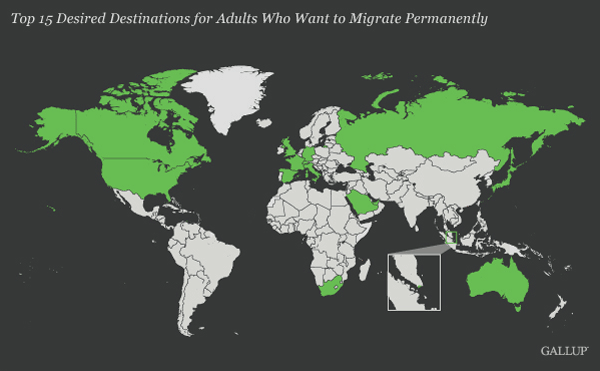
Gallup's findings on adults' desire to move to other countries are based on interviews with 347,713 adults across multiple surveys in 148 countries between 2007 and 2009. The 148 countries represent more than 95% of the world's adult population.
Together, the number of potential migrants who would like to move to the United States, which represents 24% of adults who would like to move overall, and Canada, which represents 7%, make Northern America the most desired region to move to in the world. But individually, both countries appeal to people from different parts of the world. Gallup finds the U.S. appeals more to the youngest and least educated adults, while those who choose Canada are on average slightly older and more educated.
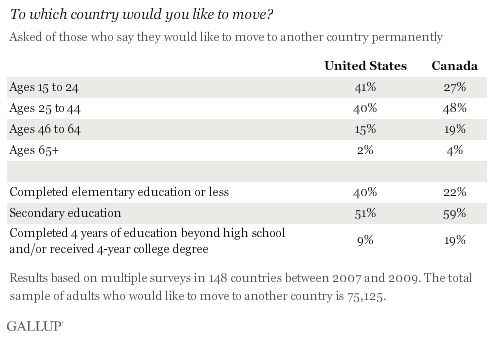
These differences may partly reflect the emphasis each country's immigration policy places on different categories of migrants. In the U.S., Department of Homeland Security statistics show family-sponsored migrants account for the largest percentage of those who become legal permanent residents each year, followed by workers. The reverse is true in Canada, where government migration statistics show applicants with higher levels of education, job experience, and skills make up the largest portion of legal permanent residents, and those in the family category make up the second-largest portion.
While the U.S. and Canada have long histories as major immigrant-receiving countries, they also differ in how they welcome new migrants and integrate them into their societies economically, politically, socially, and culturally. Canada's government actively assists migrants when they arrive, including providing free language-training vouchers. The United States on the other hand, according to a 2009 Independent Task Force report on immigration policy, has no national integration policy and provides little support for English-language classes.
United States, Canada Most Attractive in Asia
Gallup's data reflect people's desire to move to different countries, rather than actual migration rates. However, if those who would like to resettle in the U.S. and Canada actually moved, the largest migrant pool would come from Asia, followed by sub-Saharan Africa and the Americas.
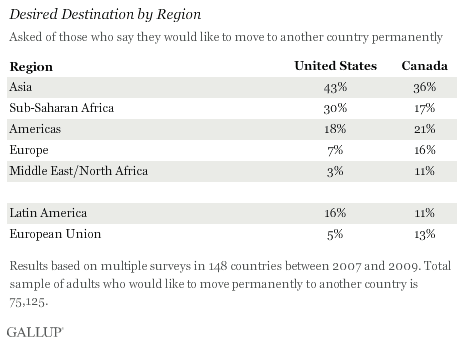
In Latin America, the United States has a slight edge over Canada among those who would like to migrate. Canada, however, is more attractive to potential migrants in Europe -- particularly those in the European Union -- and the Middle East and North Africa.
The United States Appeals to the Young
In most regions, the United States is more appealing to 15- to 24-year-old potential migrants than Canada; it has a significantly bigger draw in East Asia and the European Union. Potential migrants in sub-Saharan Africa and Southeast Asia are the notable exceptions; in those regions, the age distribution is the same for the United States and Canada.
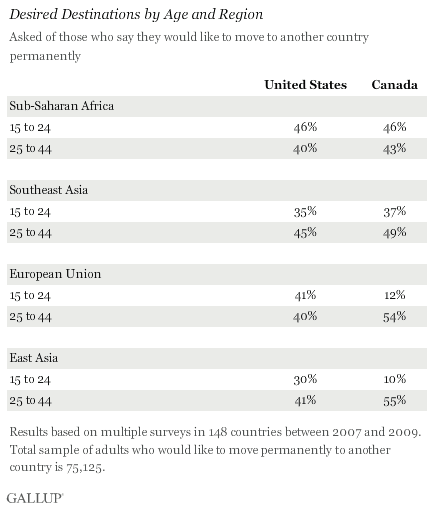
Canada's Education Edge
The United States' appeal to the least educated and Canada's greater appeal to the most educated is consistent across all regions. This is most apparent among those in the European Union, East Asia, and Southeast Asia who would like to relocate to either of these nations.
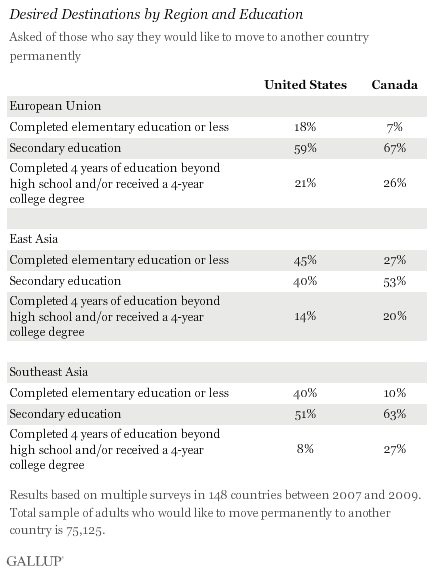
While education tends to be lower in the 15 to 24 age group -- which the United States is more likely to attract -- the overall picture does not change when age is taken into account. Within each age group, the United States is still most likely to attract the least educated.
Implications
The United States and Canada attract potential migrants for various reasons -- personal, political, or economic -- but opportunity is the common, overarching theme. People may see moving to these countries as a chance to reunite with family members who have already moved, to find jobs, or to provide better lives for their children. Immigration policy and migrant policy, too, could play a role in the talent each nation attracts. Health and social services available to them as newcomers, and their future benefits as citizens, may be yet another factor.
Regardless of why they want to move, Gallup's data provide a better understanding of who the world's potential migrants are, where they might come from, and where they want to go. This knowledge enables decision makers to develop proactive strategies for attracting the talent they desire and for integrating migrants into their societies in a way that benefits the entire population.
For custom research from the more than 150 countries Gallup continually surveys, please contact us.
For complete methodology and specific survey dates, please review Gallup's Country Data Set details.
Survey Methods
Results are based on telephone and face-to-face interviews with 347,713 adults across multiple administrations of surveys in 148 countries between 2007 and 2009. Results among adults who would like to move to another country are based on a total sample of 75,125. The 148 countries represent more than 95% of the world's adult population. Gallup's use of standardized question wording and survey methods enable the data to be reliably compared across countries and regions.
For most countries, aggregated sample sizes (across three years of surveys) range between 1,000 and 3,000 interviews. One can say with 95% confidence that the margin of sampling error, accounting for weighting and sample design, is 0.5% for the sample of adults who would like to migrate and ranges from ±2 percentage points to ±2.5 percentage points within regions. Results are projected to the total population of each country, aged 15 and older, using 2008 World Bank population estimates.
